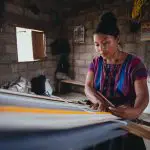Are you interested in adding a unique touch to your fabric leather creations?
In this article, we will show you how to emboss fabric leather using simple techniques.
You’ll learn how to choose the right fabric leather, prepare it for embossing, and select the perfect design or pattern.
With the help of an embossing heat tool or iron, applying pressure and heat will create a stunning embossed effect.
Get ready to enhance your fabric leather projects with this step-by-step guide.
Table of Contents
Choosing the Right Fabric Leather for Embossing
When choosing the right fabric leather for embossing, it’s important to consider the texture and thickness.
The texture of the fabric leather will determine the level of detail that can be achieved in the embossed design. Smooth leather, for example, is great for intricate designs as it allows for crisp and clear embossing. On the other hand, textured leather can give a more unique and rustic look to the embossed design.
The thickness of the fabric leather is also important to consider. Thicker leather will be more durable and will hold the embossed design better over time. However, it may require more pressure and heat to achieve a deep and defined embossing. Thinner leather, on the other hand, may be easier to emboss but may not hold up as well in the long run.
In addition to considering the texture and thickness of the fabric leather, it’s also important to choose the right embossing tools and techniques. Different types of embossing techniques, such as heat embossing or dry embossing, require different tools and materials. It’s important to research and understand the different techniques and tools available to achieve the desired embossed effect on the fabric leather.
Preparing the Fabric Leather for Embossing
Before you start, make sure you have properly cleaned and conditioned the fabric leather. This is essential to ensure that the embossing process goes smoothly and the design is well-defined.
Here’s a step-by-step guide to preparing your fabric leather for embossing:
-
Clean the leather: Use a mild soap and warm water to gently clean the surface of the fabric leather. Avoid using harsh chemicals or abrasive cleaners, as they can damage the material.
-
Condition the leather: Apply a leather conditioner to moisturize and soften the fabric leather. This will make it more pliable and easier to work with during the embossing process.
-
Allow the leather to dry: After cleaning and conditioning, let the fabric leather air dry completely. Avoid using heat or direct sunlight, as this can cause the leather to become brittle or shrink.
-
Test the leather: Before embossing the entire piece, it’s a good idea to test the embossing tools and materials on a small, inconspicuous area of the fabric leather. This will help you determine the right pressure and temperature for achieving the desired embossed effect.
Selecting the Embossing Design or Pattern
When it comes to selecting an embossing design or pattern, there are various sources of inspiration you can turn to. You can find ideas in nature, architecture, art, or even everyday objects.
Once you have chosen a design, you will need to transfer it onto your fabric leather using different techniques such as tracing, stenciling, or freehand drawing.
Design Inspiration Sources
One of the best sources for design inspiration is Pinterest, where you can find countless ideas for embossing fabric and leather.
Here are four ways you can explore different fabric and leather textures and incorporate them into your home decor:
-
Browse through Pinterest boards dedicated to fabric and leather embossing. You will find a wide range of designs and patterns to inspire you.
-
Use the search function on Pinterest to look for specific keywords related to embossing, such as ’embossed leather furniture’ or ‘textured fabric upholstery.’ This will help you narrow down your options and find ideas that match your style.
-
Follow designers and DIY bloggers on Pinterest who specialize in fabric and leather embossing. Their boards often feature their own creations and can provide valuable inspiration for your own projects.
-
Create your own mood boards on Pinterest, gathering images of embossed fabric and leather that catch your eye. This will help you visualize how different textures can be incorporated into your home decor.
With Pinterest as your design inspiration source, you’ll be able to explore various fabric and leather textures and confidently incorporate embossed materials into your home decor.
Techniques for Pattern Transfer
Pinterest is a helpful platform for finding different techniques to transfer patterns onto various materials. When it comes to pattern options, Pinterest offers a wide range of ideas, from intricate designs to simple motifs.
You can find tutorials on how to transfer patterns onto fabric, leather, and even wood. One common mistake to avoid is not properly preparing the surface before transferring the pattern. Make sure to clean the material thoroughly and remove any dirt or oils.
Another mistake is not using enough pressure when transferring the pattern. This can result in an incomplete or blurry design. It’s important to press firmly and evenly to ensure a crisp and clear pattern.
Using an Embossing Heat Tool or Iron
To emboss fabric or leather, you can use an embossing heat tool or an iron. Both options have their pros and cons, so let’s compare them.
First, let’s talk about the embossing heat tool. This tool is specifically designed for embossing and provides precise heat control. It heats up quickly and evenly, allowing you to achieve crisp and detailed embossing patterns. The heat tool also gives you more control over the embossing process, as you can easily adjust the temperature according to the material you’re working with. However, it’s important to note that embossing heat tools can be expensive and require a power source, limiting their portability.
On the other hand, using an iron for embossing is a more accessible and affordable option. Most people already have an iron at home, making it a convenient choice. However, irons may not provide the same level of precision as embossing heat tools. The temperature control might not be as accurate, and the heat distribution can be uneven, leading to less defined embossing patterns.
Applying Pressure and Heat to Create the Embossed Effect
Using an iron for embossing can result in less defined patterns due to uneven heat distribution and imprecise temperature control. To achieve a successful embossed effect, it is important to apply the right amount of pressure and heat using the appropriate embossing tools and equipment.
When embossing, the pressure you apply plays a crucial role in creating a well-defined design. Too little pressure may result in a faint impression, while too much pressure can distort the pattern or even damage the fabric or leather. It is recommended to start with a moderate amount of pressure and adjust as needed to achieve the desired result.
In addition to pressure, temperature control is equally important in embossing. Different materials require different levels of heat to achieve optimal results. It is essential to use a heat tool or embossing machine that allows precise temperature adjustment. This ensures that the heat is evenly distributed, resulting in a clear and crisp embossed pattern.
Investing in high-quality embossing tools and equipment can greatly improve your embossing outcomes. Look for tools that offer temperature control features and have a consistent heat distribution. This will help you achieve professional-looking embossed designs with sharp and well-defined patterns.
Removing the Embossing Material and Finishing Touches
Now that you have successfully applied pressure and heat to create the embossed effect on your fabric or leather, it’s time to move on to the next step: removing the embossing material and adding the final touches.
Here’s what you need to do:
-
Gently peel off the embossing material: Start by carefully lifting one corner of the material and slowly peeling it away from the fabric or leather. Take your time to avoid damaging the embossed design.
-
Use a clean cloth or brush to remove any remaining residue: After removing the embossing material, there may be some leftover residue on the surface. Wipe it off using a soft cloth or gently brush it away to ensure a clean and smooth finish.
-
Apply a final finish or protective coating: To enhance the longevity of your embossed design and add a polished look, consider applying a final finish or protective coating. This can be in the form of a clear sealant or a leather conditioner, depending on the material you are working with. Follow the manufacturer’s instructions for application.
Tips and Tricks for Successful Fabric Leather Embossing
Follow these tips and tricks for achieving successful embossing on your fabric or leather projects.
-
Choose a design that is simple and bold for pattern selection. Intricate patterns may not show up well during the embossing process.
-
Before embossing, make sure your fabric or leather is clean and free from any dirt or oils. This will ensure that the embossing material adheres properly.
When troubleshooting, there are a few techniques you can try.
-
If your embossing is not coming out as crisp as you would like, try increasing the pressure when applying the embossing material.
-
Experiment with different temperatures and durations of heat application to find what works best for your specific fabric or leather.
Another common issue is uneven embossing.
-
To fix this, make sure you are applying even pressure when embossing. You can use a rolling pin or a heat press to help distribute the pressure evenly.
-
If you are still having trouble, try using a thicker fabric or leather material. This will provide a more even surface for embossing.
By following these tips and troubleshooting techniques, you can achieve beautiful and professional-looking embossing on your fabric or leather projects.
Experiment and have fun with different patterns and materials to create unique and personalized designs.
Conclusion
Now that you know how to emboss fabric leather, you can start adding beautiful textures and patterns to your projects. Remember to choose the right fabric leather for embossing and prepare it properly before starting.
Use an embossing heat tool or iron to apply heat and pressure, creating the desired effect. Finally, remove the embossing material and add any finishing touches.
With these tips and tricks, you’ll be able to achieve successful fabric leather embossing every time. Happy crafting!
- Tetron Fabric for Marine Applications: Durability and Use Cases - June 18, 2025
- Tetron Fabric for Outdoor Furniture: Weather Resistance and Care - June 18, 2025
- Tetron Fabric for Wall Coverings: Style and Application Tips - June 18, 2025



